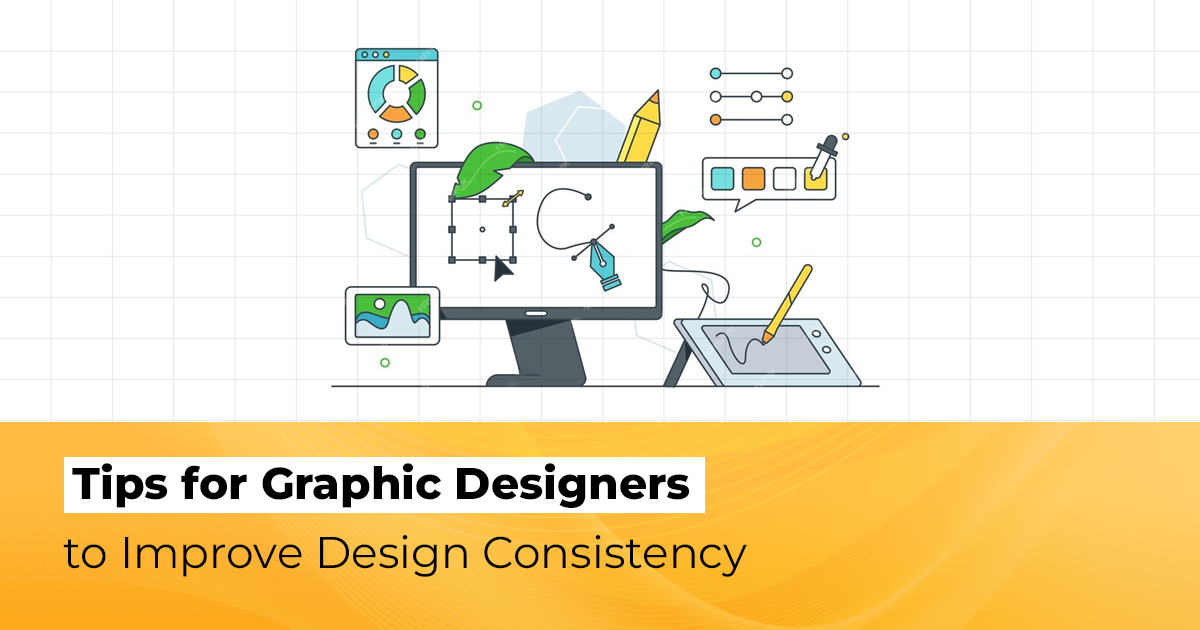
For every graphic designer, progressing towards the finish of their work is characterized through a specific core aspect: Design Consistency. It is important to have a coherent visual language, not only to develop the brand image, but most importantly, to lend credibility and professionalism in one’s designs. No sensible marketer would suggest throwaway design, especially not when creating a digital product, a brand identity, or marketing materials. This is why it is important to follow one style – to make a stunning and comprehensive impression on the audience. Here are some practical tips that can help accomplish your work in a more consistent manner.
Also Read: 5 Ways Graphic Designers Can Expand Their Skill Set
1. Formulate a Style Guide
Inconsistencies in design and visuals largely stem from a lack of style guides. A style guide defines the visual components created in all aspects of your graphic design work including colors, typography, iconography, images, and logos. Bringing together these design principles in a concise format means a lot in regard to both time and accuracy, and explains where the large margin of error exists during the design development process.
Define Key Elements:
Key elements do include some known components of a brands’ style guide i.e defined family of primary and secondary colors, set of font styles and any other unique design elements relevant to the brand.
Update Regularly:
Once a document, style guides should be considered dynamic documents and should evolve into more comprehensive documents with the growth of a brand which means they need to be updated.
Provide an Appropriate Stakeholder Communication:
The style guide should be available to all those who participate in the project to keep everyone in sync concerning the design.
2. Leverage Templates
Templates are necessary for designers who have to keep a uniform appearance in similar projects. When these designers create graphics for social media pages, or layouts for websites, or for that matter, any presentation – they ensure that every new work will compliment the previous one.
Customize for Brand Identity:
Templates should be adjusted to fit a brand’s particular style instead of looking very general.
Create for Different Formats:
Templates should also be made for commonly used formats like blog images, Instagram posts, email banners, etc. to create a quicker workflow and maintain the consistency of the branding.
Set up Layers and Guides:
Incorporate features such as grids, guides, and layers in the templates which will help reduce the amount of repositioning and adjustment of the layout that may be required.
3. Employ a Uniform Color Scheme
Color, as we all know, is an important element of design that enhances brand equity and conveys a feeling. Repeatedly using a dominant color creates quick and static associations with the image of your design.
Establish a Two-Tone Palette:
The first one is called a primary palette, which forms the backbone of nearly every shade core. Secondary palettes, on the other hand, provide support, or add to the main selections. Do not change these colors frequently and make sure these colors are aesthetically pleasing.
Make Sure Accessibility is Covered:
Color contrast is key in enhancing the legibility of designs and promoting inclusivity, especially in the case of graphics on websites. Go for the contrast ratio of 5: 1 in order for your designs to be fit even for the users who have low vision problems.
Do Not Test Different Colors:
Unless there is such a reason, do not change colors in the average palette. Stick with them for desired reasons.
4. Implement a Clear Typographic Hierarchy
Typography defines a design that is structured and easy to read. This is achieved as long as the typographic hierarchy is maintained for every text element so that every text element can have its purpose and attract the corresponding eye.
Reduce the Number of Font Families:
Multiple font families lead to the visual chaos of the text. Select one to three typefaces for headings, sub-headings, and body texts that attribute complementarity.
Distribute Font Sizes and Weights Beyond a Level:
Sizes, weights, and styles of headers, subheaders, or paragraph text should be fixed. By doing so, a professional and uniform outlook is created to the design as each of the elements possesses its order in the hierarchy.
Use Style Sheets within Applications:
Software applications such as Adobe Illustrator and Figma have the capacity of designing and storing style sheets of fonts thus enabling one to preserve the same look with less effort.
5. Avoid Common Misconceptions about Redundancies
Spacing and alignment play an essential role in shaping visually appealing designs. With the right amount of space, you can ascertain that your elements are in order and that the overall design is neat and simple.
Don’t Ignore Grid Structure:
Grids are structures that organize the placement of your future elements and help achieve proper proportions. They are especially needed when dealing with complicated presentations, such as web pages or brochures.
Control between Elements should be the Same:
Establish and adhere to designated spacing in the text as well as the surrounding areas of the other objects. This level of concern in the little things adds a lot of beauty to the overall framework of the design.
Elements must be Aligned Accurate:
What happens when parts of the page are not aligned properly? The entire picture is an eye sore and it is unpleasant, ideally one most wishes to avoid. To prevent this, always use the alignment tools in your design program when positioning elements on a single page.
6. Emphasize Visual Balance
Visual balance is essential for maintaining similarities. It helps avoid the treatment of one of the elements in your design more than the others and therefore creates a sense of wholeness.
Symmetrical and Asymmetrical Balance:
The symmetrical designs suggest stability and balance while the asymmetrical ones might be useful in creating interest. Depending on the particular brand, decide which balance to use .
Use The Concept Of White Space:
White space is quite a useful space in the composition, yet it is usually disregarded. It creates room for other elements and most importantly, it helps to make the designs uncluttered.
Size All The Elements:
Size of elements such as icons, buttons, and text boxes should be consistent so as not to make the layout pessimistic.
7. Design Software for Process Improvement
If used correctly, your design software becomes an extension of yourself. The majority of design software nowadays includes options that promote consistency and the execution of redundant activities.
Build Asset Libraries:
Design platforms not only enable you to incorporate style libraries into your projects (including colors, fonts, and icons), but also develop components that can be reused throughout your projects (e.g. buttons ACF, Figma). When these items are placed in the project, all design elements are required to comply with the standard.
Generate Symbols or Components:
Every tool has its own set of terminology, but the main concept is the same: symbols (or components in certain tools) allow you to create different reusable items, such as buttons or icons, which can easily be modified throughout the entire project. This is crucial for interface construction.
Engage in Simultaneous Editing:
Numerous design applications now allow for simultaneous editing, which is essential in achieving uniformity over a team. If the team is definitely looking at the same file, it makes sense for them to apply the same conditions and make changes that everyone can see at once.
8. Keep Learning and Experimenting
Achieving design consistency does not equate to suffocating creativity. Consistency and creativity should go hand in hand, because great designers adapt to the latest developments and constantly improve their design practices.
Follow Current Trends of the Industry:
Let your work remain current by utilizing the tools of the trade. The majority of clients want a designer who has an up-to-date outlook on things.
Create Mental Models Using Personal Affairs:
Try to approach personal affairs as mental models. Creativity is not a sin, but it takes a lot of experimentation outside of the client project to avoid compromising on the brand.
Participate In Design Workshops:
Attendance at design workshops or taking online courses will help you discover new methods of achieving consistency without restraint.
Conclusion
Designing consistently, requires a lot of control and detail but the end results are worth it. All designs should appear uniform in style because content, processes, color scheme and typeface are clearly structured. There is no doubt that in the modern world it is very essential to maintain a consistent vision in order to stand out from one’s peers and take your work to the next level.

